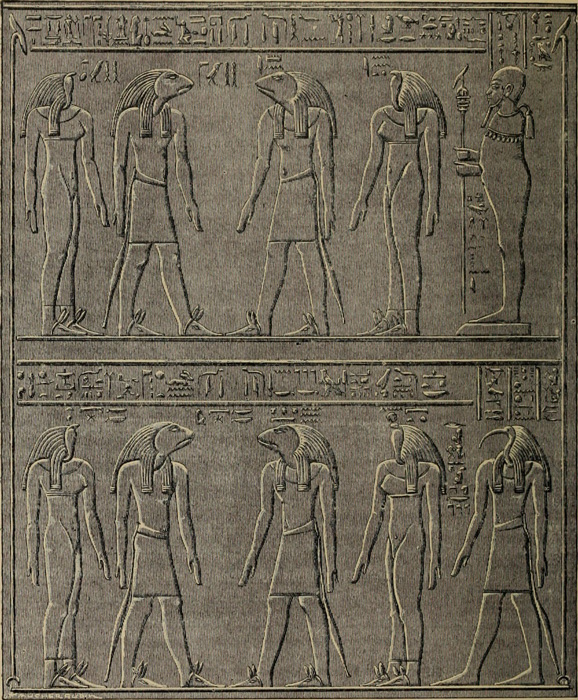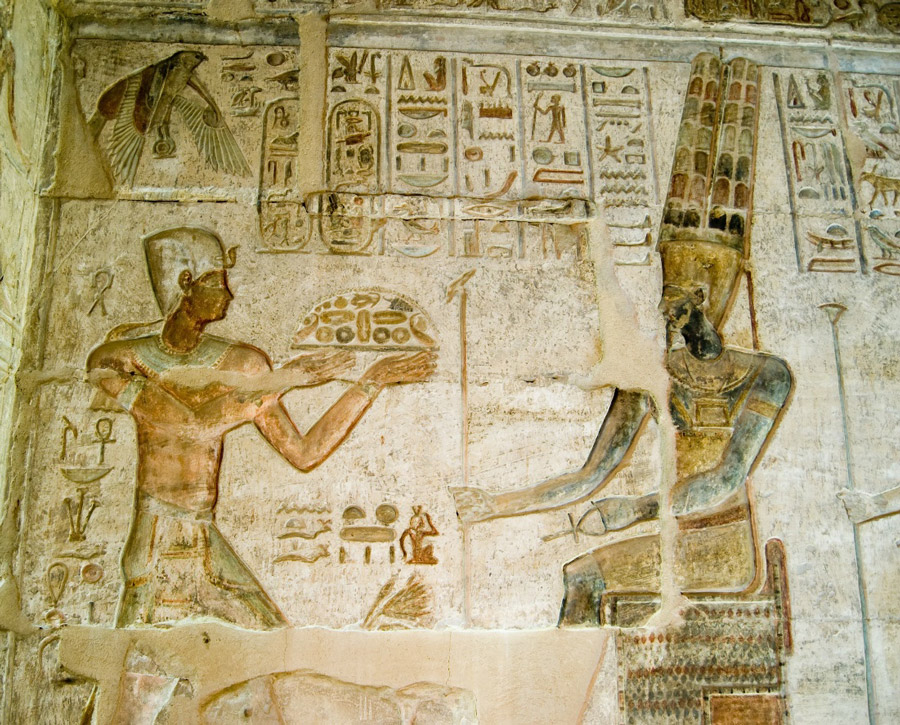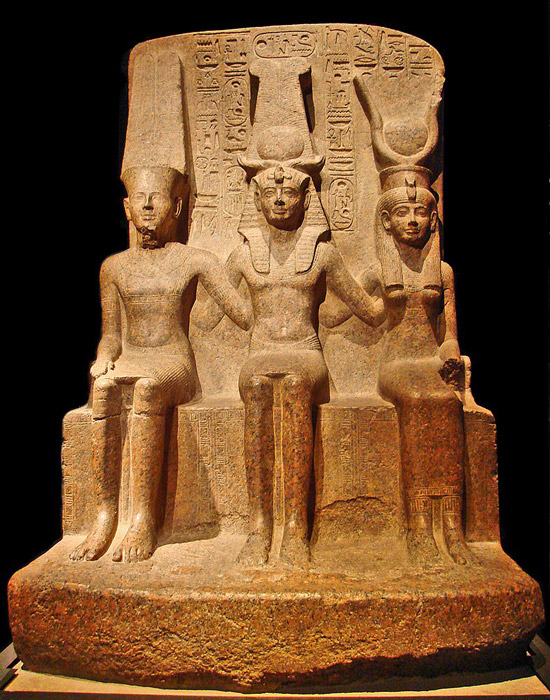The Egyptian gods are one of the best-known pantheons. Names such as Isis and Osiris, Horus, Anubis and Ra are familiar in the modern era, rivalling even the Greek and Roman pantheons.
However there is one god in the Egyptian pantheon who is mysterious to modern researchers, and apparently this is by design. Amun, the “hidden one” would ultimately rise to rule the gods as Amun-Ra. This was largely due to Amun being the patron deity of Thebes, a city instrumental in driving out the foreign Hyksos pharaohs.
But Amun was an old god indeed, and his resurgence to lead the Egyptian pantheon marked the second time he was elevated to become chief god. Far back in the early days of the Old Kingdom of Egypt, around 2,400 BC, Amun had ruled as part of the Ogdoad at Hermopolis.
What was the Ogdoad?
The Ogdoad relates with the city of Hermopolis, the “City of Hermes” as the Greeks called it. The name Hermopolis was given by the Greeks because they associated the city with the Egyptian god Thoth, whom the Greeks saw as a form of Hermes.
Thoth was however not a part of the Ogdoad, the system of eight primordial gods and goddesses that the Egyptians believed in. The Egyptian name for the city, long before the Greeks renamed it, was Khemenu, the “eight town” for the eight gods of the Ogdoad.
The Ogdoad was made up of four gods and their consorts. The number four was considered as the number of completeness in Egyptian beliefs. Therefore, the Egyptians believed that these four pairs of gods represented the four creative powers of the universe.

Unlike the later gods of Egypt, these gods represented the primordial forces of nature, the first and oldest gods in the pantheon. In then, we find the Egyptian myths of the creation of the world, among the earliest in human history.
Nun and Naunet
Nun represented the primeval waters of the world that led to the initial process of creation. The God Nun is sometimes considered a very old god, even older than the Sun god Ra. Nun was represented as a blue-green-skinned man with a frog’s head.
There were very few temples dedicated to the god Nun, as the ancients believed he lived in the sacred lakes of temples. It is believed that the sun god Ra also emerged from the waters of Nun.
Nun forms a celestial pair with the goddess Naunet, a snake-headed goddess who represents the primordial abyss of the underworld. Snakes, who emerge from holes in the earth and bring death, are often associated with the underworld.
Along with her consort Nun, she ruled over the primeval waters and the abyss beneath it. Many religions see waters as the gate to the underworld, and so Nun guarded the entrance to the next life, where Naunet ruled.
Kuk and Kauket
Kuk and Kauket represented the primordial darkness or chaos. The pair were seen as controlling the darkness in the universe, and in some instances the light which could only manifest because of the darkness.
In this way, they were “gateway” gods in a similar fashion to Nun and Naunet. They were tasked with guarding and ensuring the cycle from light to dark, and ruling over the vast darkness beyond ancient Egyptian understanding.
Kuk, the male God, is again represented as a frog or a frog-headed man like Nun. He was also called the bringer of light, and signified by dawn. Kauket, his female counterpart, was the manifestation of darkness or chaos. She is represented as a snake-headed woman, as with Naunet.
Huh and Hauhet
We know very little about the gods Huh and Hauhet. Huh appears to be the male God of infinite space that took the shape of the sky for the earth. The name Huh apparently represents endlessness.
It is believed that Huh was worshipped for a long and healthy life, and he was also seen as the God of time. Hauhet, on the other hand, is the goddess of infinity and rules the infinite space with Huh.
This would fit with the structure of the other paired gods of the Ogdoad. The male deity rules the gateway and acts as a form of gatekeeper, to be worshipped as an important guard. The primordial and unknowable spaces beyond were ruled by the female consorts of these gods.
Amun and Amuhet
These six gods and goddesses were joined by two more who manifested the divine energy of the gods. The chief male of the gods was known as Amun. While all the other gods were seen with frog heads or snakeheads, Amun was considered more of a primeval force.

He was the god of winds or ruler of the air, hidden and invisible. Later, after his association with Ra and his elevation to the head of the Egyptian pantheon, he was often depicted with a ram’s head, but here he appeared either as a man, or without form entirely.
Amun’s consort in the Ogdoad was the mother goddess Amunet. Amunet is also an air or wind goddess. She is considered a female manifestation of the life-bringing northern winds.
Amunet is also seen as the tutelary deity of pharaohs and plays a huge role in their education and accession. The consort of Amun was also worshipped as a fertility goddess for Upper (southern) Egypt.
Although Amunet was later replaced by Mut as the consort of Amun, she still remains by the side of Amun at Karnak, the center of primordial Egyptian worship. She is often associated with the underworld because of her title of Hidden One. She also plays a primary role in funeral rituals and welcoming the dead into the afterlife, into the realm of Naunet.
The Creation of Egypt
These eight gods and goddesses, representing primeval forces of life, interacted in the void, which created an explosion. This powerful interaction, like an ancient Big Bang, brought all of creation into being.
The explosion led to the creation of an ancient mound, that rose from the primeval waters. The mound was called the Isle of flame in Egyptian scriptures. This isle of flame, with its light and life, was ruled the eight gods and goddesses during what the ancient Egyptians saw as a Golden Age.
When the golden age drew to a close the Isle of Flame was lost, and the primordial gods of the Ogdoad lived in the underworld or the Duat. However the creation they had brought into being, although ruled by younger gods, endured with their shadowy, background presence.
These ancient gods, responsible for the powers of life and death, guardians of the underworld, the primordial chaos and the empty darkness, remained as powerful figures in the Egyptian pantheon.
Thebes, and Amun’s Second Family
As the centuries past the worship of the Ogdoad appears to have become simplified into worship of Amun, who represented the original eight gods. Amun’s chief temple was at Thebes, where he was associated with funerary rituals.
Amun at Thebes formed part of a triad of gods, a holy family separate from the Ogdoad. His wife in the new order was Mut, a vulture-headed goddess who was worshipped as the patron goddess of Thebes.

Mut adopted aspects of other gods from the Ogdoad. She was considered a mother goddess and was often called the mother of mothers. She was also a sky goddess from whom everything originated, her name itself meaning “mother”.
She was also considered as the world mother or the mother of pharaohs. Mut is often portrayed as a goddess wearing the wings of a white vulture and is also seen with double crowns that signify the combined rule of Upper and Lower Egypt.
The Hermes at Hermopolis
Thoth was the son of Mut, and the last god in the Theban triad. He was seen as the master of time, and associated by the later Greeks with their messenger god Hermes, called Mercury by the Romans.
Thoth was the god of the Moon, and his name means “wanderer” signifying the nature of the moon following travelers as they journey across the deserts of Egypt. Thoth had the head of an ibis, a bird sacred to the Egyptians, and often wore a headdress with a full moon or a crescent sign. He is also called the “pathfinder” as he guides night travelers towards their destination.
These three gods, Amun, Mut and Thoth, would form the central family of Thebes, and with the Theban victory against the Hyksos and the installation of the 18th dynasty ruling the united Egypt of the New Kingdom, Amun became the chief god of the pantheon.
Credited with this victory, Amun would once again rule the gods, as he had a thousand years earlier during Egypt’s mythical first Golden Age. And, as Ammon-Zeus, he would rule again.
Top Image: Detail from the Dendera Temple in Egypt. The Ogdoad stand to the left. Source: kairoinfo4u / CC BY-NC-SA 2.0.
By Bipin Dimri